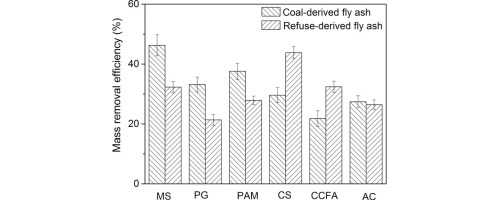Particuology ( IF 4.1 ) Pub Date : 2017-10-05 , DOI: 10.1016/j.partic.2017.06.006 Deshuai Sun , Xiaodong Zhang , Zhongyi Zhang , Long Fang , Hui Du

|
Airborne inhalable particles are a potent environmental pollutant. Formed via industrial processes, separation of these particles is difficult using conventional clean up techniques. In this work, solid nuclei particles of different chemical compositions were introduced into an agglomeration chamber with simulated flue gases to investigate their ability to remove these particles. Organic nuclei were able to capture more inhalable particles from coal-derived fly ash than inorganic nuclei, though these proved more effective for the agglomeration of inhalable particles in refuse-derived fly ash. Increasing the diameter of the solid nuclei benefitted the agglomeration process for both types of ash. Varying the local humidity changed adhesion between the particles and encouraged them to aggregate. Increasing the relative humidity consistently increased particle agglomeration for the refuse-derived ash. For coal-derived fly ash, the removal efficiency increased initially with relative humidity but then further increases in humidity had no impact on the relatively high efficiencies. After agglomeration in an atmosphere of 62% relative humidity, the mean mass diameter of inhalable particles in the coal-derived fly ash increased from 3.3 to 9.2 μm. For refuse-derived fly ash, agglomeration caused the percentage of particles that were less than 2 μm to decrease from 40% to 15%. After treatment at a relative humidity of 61%, the mean size of inhalable particles exceeded 10 μm.
中文翻译:

从煤中去除可吸入颗粒,并通过与固体核的团聚来拒绝燃烧
空气中的可吸入颗粒物是一种潜在的环境污染物。通过工业过程形成,使用常规的净化技术很难分离这些颗粒。在这项工作中,将具有不同化学成分的固体核颗粒引入带有模拟烟气的团聚室中,以研究其去除这些颗粒的能力。有机核能比无机核捕获更多煤源粉煤灰中的可吸入颗粒,尽管这些被证明对于可吸入颗粒在垃圾衍生粉煤灰中的聚集更为有效。增大固体核的直径有利于两种灰分的团聚过程。改变局部湿度会改变颗粒之间的附着力,并促使它们聚集。相对湿度的增加会不断增加垃圾衍生灰分的颗粒团聚。对于源自煤的粉煤灰,去除效率最初随相对湿度而增加,但随后湿度的进一步增加对相对较高的效率没有影响。在相对湿度为62%的气氛中结块后,煤制粉煤灰中可吸入颗粒物的平均质量直径从3.3μm增加到9.2μm。对于垃圾衍生的粉煤灰,结块导致小于2μm的颗粒百分比从40%降低到15%。在相对湿度为61%的条件下处理后,可吸入颗粒物的平均大小超过10μm。去除效率最初随着相对湿度而增加,但随后湿度的进一步增加对相对较高的效率没有影响。在相对湿度为62%的气氛中结块后,煤制粉煤灰中可吸入颗粒物的平均质量直径从3.3μm增加到9.2μm。对于垃圾衍生的粉煤灰,结块导致小于2μm的颗粒百分比从40%降低到15%。在相对湿度为61%的条件下处理后,可吸入颗粒物的平均大小超过10μm。去除效率最初随着相对湿度而增加,但随后湿度的进一步增加对相对较高的效率没有影响。在相对湿度为62%的气氛中结块后,煤制粉煤灰中可吸入颗粒物的平均质量直径从3.3μm增加到9.2μm。对于垃圾衍生的粉煤灰,结块导致小于2μm的颗粒百分比从40%降低到15%。在相对湿度为61%的条件下处理后,可吸入颗粒物的平均大小超过10μm。结块导致小于2μm的颗粒百分比从40%降低到15%。在相对湿度为61%的条件下处理后,可吸入颗粒物的平均大小超过10μm。结块导致小于2μm的颗粒百分比从40%降低到15%。在相对湿度为61%的条件下处理后,可吸入颗粒物的平均大小超过10μm。











































 京公网安备 11010802027423号
京公网安备 11010802027423号